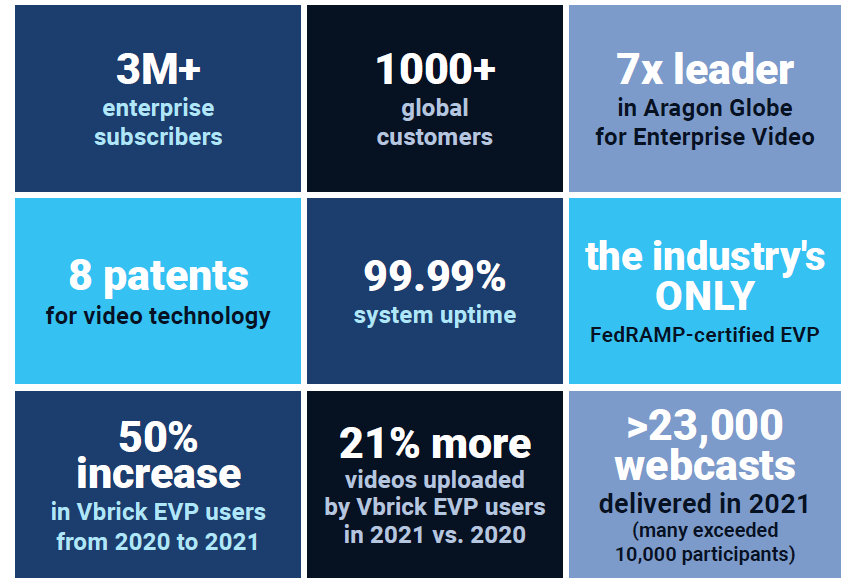The Ultimate Enterprise Video Platform Buyer’s Guide
Share on Social
- Introduction: Enterprise Video Use is Exploding – and It’s Here to Stay
- What an EVP is – and is Not
- Consideration 1: End-to-end Functionality
- Consideration 2: Video Streaming
- Consideration 3: Video Content Management
- Consideration 4: Data Protection
- Consideration 5: Analytics
- Consideration 6: Integrations and Partner Ecosystem
- Enterprise Video Platform Buyer’s Checklist
- Partner with the Right EVP Provider
Introduction: Enterprise Video Use is Exploding – and it’s Here to Stay

1Source: World Economic Forum | 2Source: Mordor Intelligence | 3Source: Mordor Intelligence 4Source: Aragon Research
Live and asynchronous video use in the enterprise has exploded, transforming the way people engage, learn, innovate, and build powerful brands. The shift to hybrid work models only further accelerated a massive, global trend that was already in motion, firmly cementing video as a foundational pillar of modern enterprise communications.
Taking their cue from leading brands at the forefront of the enterprise video revolution, organizations across industries and geographies are turning to comprehensive enterprise video platforms (EVPs) to unlock the true power of video. Relatively new to the scene, EVPs promise to unify video capabilities, delivering a single, end-to-end way to manage video content and deliver video experiences across large, global networks — no matter where viewers are located or what devices they use.
Yet not all EVPs are created equal. Platform functionality and overall quality varies significantly from provider to provider today. While the total addressable market for EVPs is vast and continuously growing, it is still largely uncharted. Facing heightened enterprise requirements, existing video content industry players continue to struggle to overcome pervasive operational, performance, security, and integration challenges and successfully adapt their services.
So how do you make the best choice for your enterprise? This guide highlights key requirements to help you select the right EVP partner for your
unique — and ever-expanding — enterprise video needs. Use the questions throughout the guide when evaluating providers, so you can build a winning, comprehensive enterprise video communications strategy for today — and tomorrow.
What an Enterprise Video Platform is – and is Not
Before delving into key purchasing considerations, it’s important to clearly define what an enterprise video platform is…and is not.
EVPs are often confused with video streaming services — such as Netflix and YouTube that have transformed consumers’ online entertainment experiences — as well as video conferencing solutions — such as Zoom, Webex, and Microsoft Teams, that became central to maintaining business operations in the wake of COVID-19. Yet EVPs are neither of these things.
Following is a comparison of the most comprehensive EVP on the market alongside a typical video conferencing solution and video streaming service.
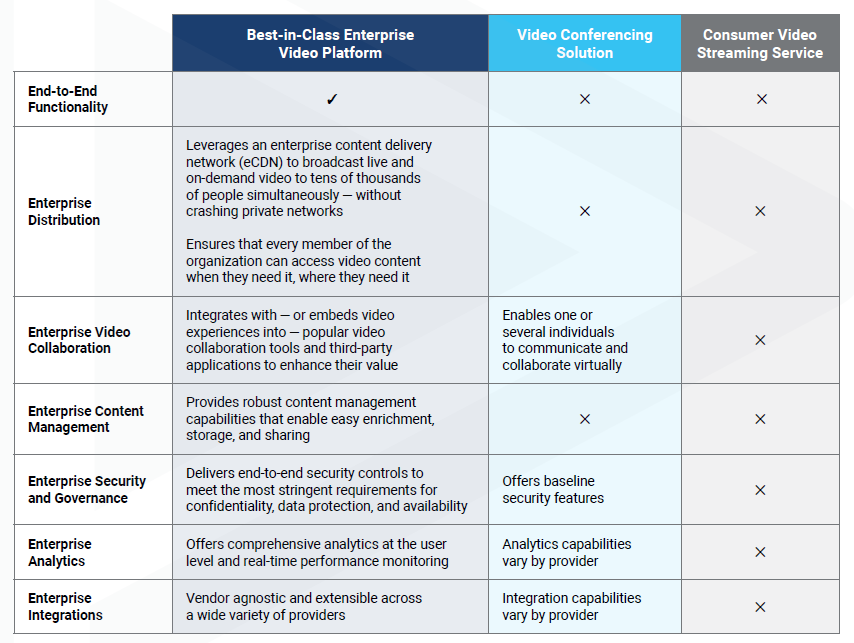
Consideration 1: End-to-End Functionality
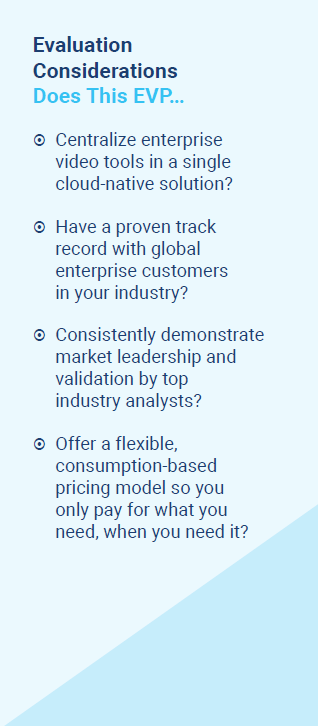 Your enterprise video requirements are growing rapidly to enable business-critical communications across your ecosystem of employees, partners, and customers.
Your enterprise video requirements are growing rapidly to enable business-critical communications across your ecosystem of employees, partners, and customers.
Instead of investing in multiple tools to address various use cases, you need an end-to-end solution that’s comprehensive yet flexible enough to evolve with your business.
Best-in-class enterprise video platforms provide a broad range of capabilities to enable live video and on-demand streaming, content enrichment, distribution, and governance in once centralized, intuitive solution. And as organizations increasingly turn to SaaS to reduce costs and operational complexity while accelerating time to value, cloud-native EVPs offer auto-scaling based on current requirements – so you only pay for what you use.
Experience Matters
When you consider the increasingly critical role video plays in your organization, the experience of your technology provider matters. The right EVP partner needs to be one with a proven track record, visionary product approach, impressive client roster, and world-class team committed to your continued success. And as data security and privacy requirements increase around the world, selecting a partner that can protect your sensitive video assets — from intellectual property to confidential internal communications — is paramount to preserving your brand reputation and competitive edge in the market.
Consideration 2: Video Streaming
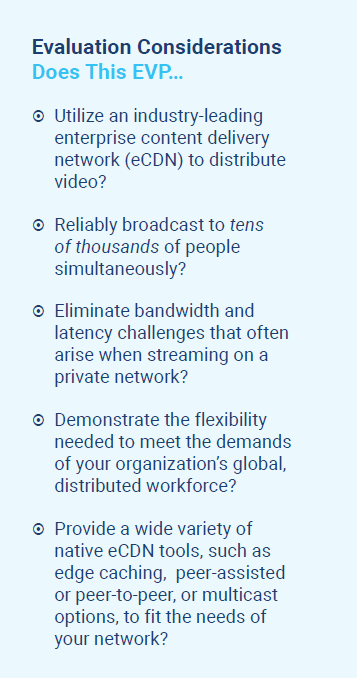 The number one priority for most organizations in the market for EVPs is reliable video streaming for both live and on-demand content at scale. Whether it’s a company-wide meeting, a training course, or a division announcement, organizations need a way to deliver high-quality video to every single participant — whether there are 100 or 100,000 people in attendance.
The number one priority for most organizations in the market for EVPs is reliable video streaming for both live and on-demand content at scale. Whether it’s a company-wide meeting, a training course, or a division announcement, organizations need a way to deliver high-quality video to every single participant — whether there are 100 or 100,000 people in attendance.
Yet too often, individuals responsible for virtual meetings have seen presenter and user experiences suffer due to slow networks, diminishing the overall quality of the event, and sometimes even tarnishing brand reputation. The shift to long-term hybrid work models pushed video streaming to the limits, underscoring the need for highly reliable delivery mechanisms that can handle unprecedented bandwidth and performance requirements. By leveraging commercial video enterprise content delivery networks (eCDNs), cloud-native EVPs make it possible to deliver amazing video experiences to every person, on every device, every time.
Enter eCDNs: An Essential Video Distribution Component
The best eCDNs flawlessly deliver live video streaming to multiple locations using the corporate network. Not all eCDNs are created equal though — some only use one type of distribution technology. Choosing an EVP with a variety of options, like edge caching, peer-to-peer, and multicast, helps you optimize your network and create the best solution based on your office locations, the number of people working in them, and the infrastructure.
As part of your evaluation, consider your work from home policy and account for employees who will be splitting their time between home and the office. Work with an experienced EVP provider that has a team of experts who can understand your infrastructure and recommend the best design. EVPs that have a built-in eCDN should include a dashboard that shows real-time performance to monitor users’ experience and pinpoint any network bottlenecks. With the right solution in place, latency and buffering issues that can arise with live and on‑demand video viewing will be a thing of the past.

Consideration 3: Video Content Management
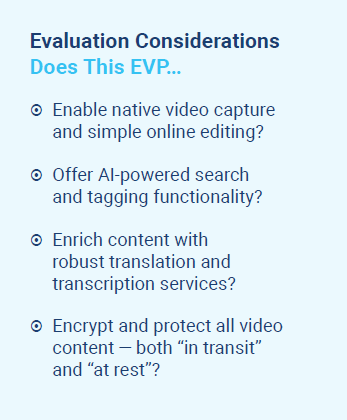 Teams across your enterprise have spent significant time and resources creating compelling video content — from training videos that help bridge skills gaps, to industry webinars that showcase thought leadership. But as video libraries expand, the following content management challenges become more pronounced:
Teams across your enterprise have spent significant time and resources creating compelling video content — from training videos that help bridge skills gaps, to industry webinars that showcase thought leadership. But as video libraries expand, the following content management challenges become more pronounced:
- Massive HD video files can quickly push internal storage capacities to the max, while sharing these unwieldy files can be challenging.
- People spend valuable time and resources creating compelling content. But these assets often get overlooked, lost in emails, chats, or even duplicated because people don’t know they exist.
- Critical information-sharing lags as content goes through costly and time-intensive translation and transcription cycles.
The right EVP can help your organization overcome these hurdles by making it easy to create, search, share, and enrich video content. EVPs empower users with self-service video creation and editing capabilities that only require a web browser, webcam, and/or the user’s video conferencing platform of choice. Once content is created, it is stored in a single, secure cloud repository. AI-powered searchability — by speaker, topic, or clip — helps users navigate the content library and quickly find the videos they’re looking for.
Real-time translation and transcription functionality make video content instantly accessible and inclusive for large, diverse audiences. Because these services are automatic, they can also be used to enhance search capabilities. For instance, if users can’t remember the title of a video or when it was recorded, they can simply search relevant keywords mentioned in a transcription to narrow their search.
Combined, these advanced content management features drive increased engagement and productivity by ensuring people can access the right information, right when they need it.

Consideration 4: Data Protection
As cybercrime becomes more profitable and organized, digital attacks have reached an all-time high.

1Source: Cybersecurity Ventures | 2Source: IBM | 3Source: Identity Theft Resource Center | 4Source: Risk Based Security/Flashpoint | 5Source: Check Point Research
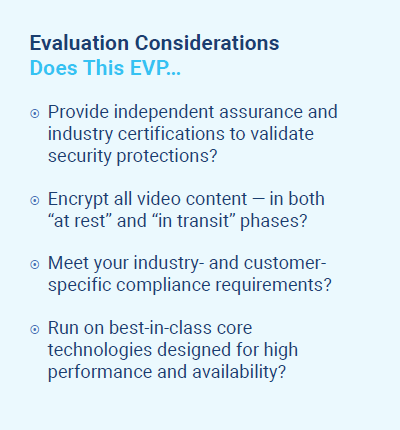 Without proper security protections in place, enterprise video content can expose information and create risk — from when it’s first created, to when it is live-streamed, to when it is stored, shared, and accessed on demand. Yet many popular video platforms weren’t designed with enterprise security requirements in mind. The right EVP should enhance your organization’s overall security posture and help keep sensitive video content — such as earnings or pre-acquisition communications, internal product launch previews, or even proprietary training tutorials — out of the wrong hands.
Without proper security protections in place, enterprise video content can expose information and create risk — from when it’s first created, to when it is live-streamed, to when it is stored, shared, and accessed on demand. Yet many popular video platforms weren’t designed with enterprise security requirements in mind. The right EVP should enhance your organization’s overall security posture and help keep sensitive video content — such as earnings or pre-acquisition communications, internal product launch previews, or even proprietary training tutorials — out of the wrong hands.
This starts by encrypting and protecting all video content — in both “at rest” and “in transit” phases — to minimize data leaks. Look for platforms that offer end-to-end governance that integrates and aligns with your organization’s access permissions, retention policies, and network requirements. This is particularly important for organizations in highly regulated industries such as financial services and healthcare.
Tight security controls don’t just keep malicious attackers from accessing sensitive data, they also ensure users have the proper permissions before creating, posting, and sharing sensitive video content. For maximum oversight, design publication workflows can be implemented to confirm content is properly vetted and approved before it’s broadcast or added to the content library.
As part of the evaluation process, potential EVP partners should provide independent validation that their platform meets the highest industry standards for security and compliance.

Consideration 5: Analytics
The best EVP for your business will provide video analytics that unlock powerful new insights on user preferences and behaviors. Platforms that provide comprehensive data on viewing times, drop offs, completion rates, and more at the individual viewer level can help drive numerous strategic improvements.
- For content amplification and personalization, by identifying which individual videos are driving the most value for users
- For live event optimization, by surfacing real-time analytics that can be used by tech teams to optimize the user experience and troubleshoot any streaming issues that arise at either the network or user level
- For compliance, by understanding who has (and has not) viewed mandatory videos
- For identifying big-picture trends, by aggregating user analytics to drive continuous improvements to your video communications and overall engagement strategies

Consideration 6: Integrations and Partner Ecosystem
An effective EVP should demonstrate an ability to maximize customer value by partnering with a robust ecosystem of technology, application, integration, channel, and service partners.
For example, by integrating the EVP with popular video conferencing solutions such as Microsoft Teams, Webex, and Zoom, enterprises can leverage their existing unified communications investments while taking advantage of enhanced user features — from live captioning and chat capabilities, to browser-based video creation and editing tools, to one-click searches that make finding and sharing video content easy.
IT decision makers should be cautious of EVP options that seem less costly at first, but don’t provide sufficient integrations or support alliances with other product offerings. Skimping on proven integration techniques or failing to take advantage of the collective strengths of leading technology, application, and service partners can result in infrastructure challenges, added complexity, and technical debt down the road.

Enterprise Video Platform Buyer’s Guide Checklist
Not all EVPs are created equal. Use these questions when evaluating potential partners, so you can build a winning, comprehensive enterprise video communications strategy for today – and tomorrow.
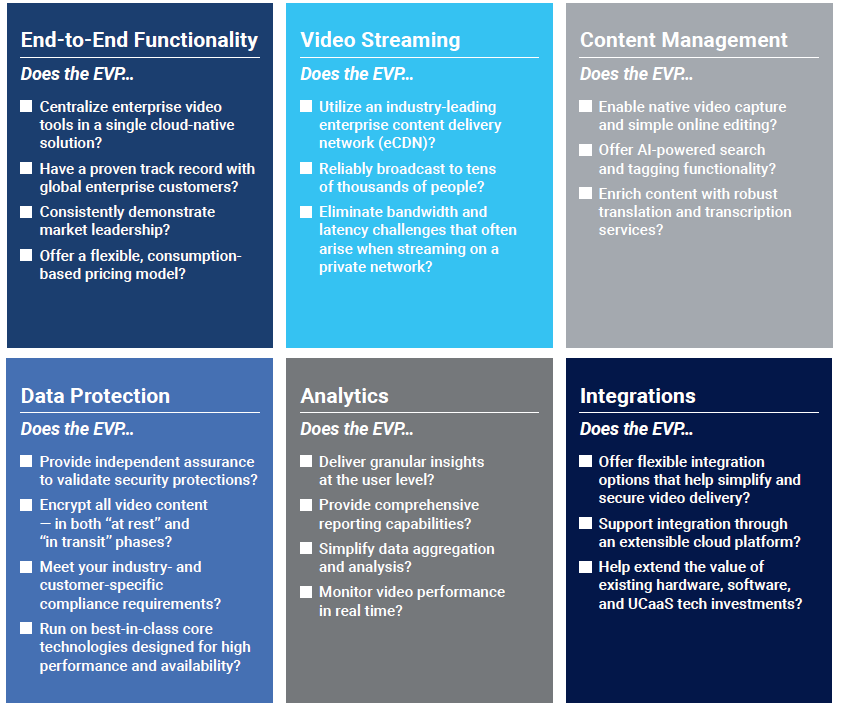
Partner with the Right EVP Provider
Vbrick is the leading cloud-native enterprise video platform on the market. The end-to-end, cloud-native solution removes operational, performance, security, and integration barriers to adoption, unlocking the true power of video for the enterprise.
The Vbrick Enterprise Video Platform enables the modern digital workplace with live and on-demand video streaming at scale, video capture, video content management, comprehensive analytics, and seamless integration with leading video conferencing solutions. Its unique ability to deliver the right video content to the right people at the right time, in the most highly secure fashion, is unmatched in the industry.
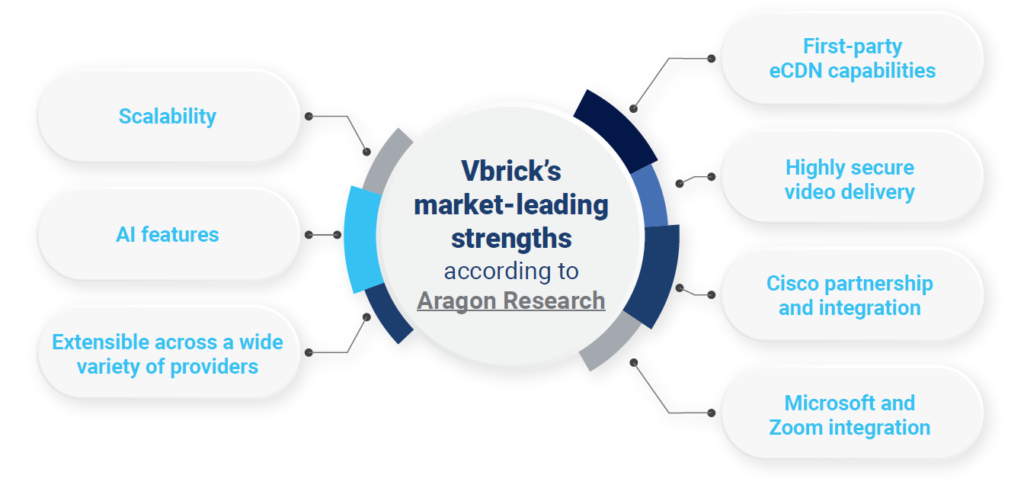
The Proof is in the Numbers
